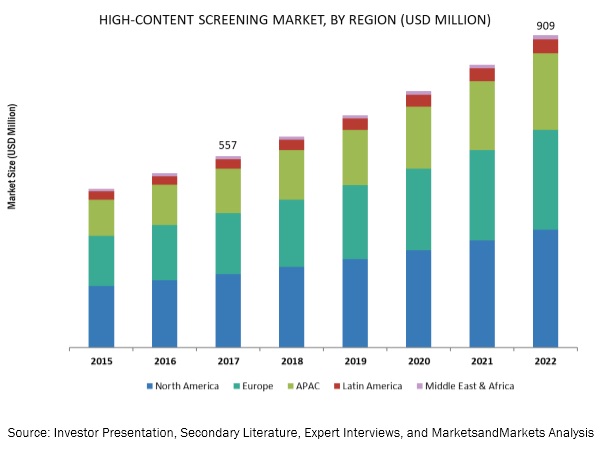Across the globe, the adoption of high content screening for primary screening is increasing due to factors such as increased throughput, enhanced accuracy, and ease of use. A number of automated HCS instruments are available in the market. Moreover, market players are engaged in developing new automated HCS instruments with higher throughput, which will help the market grow further.
Early buyers will receive 10% customization on reports @ https://www.marketsandmarkets.com/pdfdownloadNew.asp?id=42710391

High Content Screening Market report is segmented based on product, application, end user, and region. This report also discusses the key market drivers, restraints, opportunities, and challenges for this market and its submarkets.
The factors expected to drive the growth of the market are rising need for cost containment in pharmaceutical R&D, growth in funding for cellular research, and technological advancements in HCS solutions during the forecast period. The increasing number of contract research organizations providing HCS outsourcing services and application of HCS in personalized medicine offer significant growth opportunities in the HCS market. The rising adoption of label-free technologies and growing focus on stem cell analysis are the key trends in the HCS market.
Taking into consideration the growing demand for HCS products, various venture capitalists are now investing in this market. For instance, in November 2011, the Entrepreneurs Fund (U.K.) and Sham (France) invested $10 million in Cytoo SA (France), a company that offers products and services for high content analysis, cell-based assays, and cell screening processes. Furthermore, in October 2011, Kernel Capital invested $1.11 million (€800 thousand) in Biocroi Ltd., a company that develops multi-well microplates for high content screening. In addition, various companies in Europe are focusing on collaborations in order to enhance their expertise in the high content screening technology. For instance, in December 2013, Evotec Technologies (Germany) and QIAGEN (Netherlands) signed an agreement to promote the advantages of combining QIAGEN’s RNAi products with Evotec’s Opera high content screening platform. This will enable researchers to carry out high-quality gene analysis. All these factors have presented an array of opportunities for the high content screening market to flourish in the coming years.
Recent Developments
- In February 2017, Molecular Devices, LLC (U.S.), a subsidiary of Danaher Corporation, launched the SpectraMax iD3 Multi-Mode Microplate Reader, a solution which allows multiple SpectraMax iD3 instruments to be controlled from one workstation using network connectivity. .
- In January 2017, PerkinElmer, Inc. launched the Vectra Polaris automated quantitative pathology imaging system. This multi-modal tissue imaging system enables researchers to gain a deeper level of understanding of disease mechanisms related to new cancer immunotherapy approaches.
- In November 2016, Merck Millipore collaborated with Evotec AG (Germany), to provide screening services for Merck’s collection of genetic reagents such as CRISPR and shRNA libraries. With Evotec’s screening expertise, Merck was able to explore and identify new drug targets.
- In August 2015, Becton, Dickinson and Company acquired Cellular Research, Inc. (U.S.), a biotechnology R&D company. Through this acquisition, BD combined its BD FACS single-cell sorting instrumentation and software with Cellular Research’s Precise assays based on the Molecular Indexing technology to offer customers an integrated workflow for measuring both nucleic acid and protein expression in cellular subtypes.
To speak to our analyst for a discussion on the above findings @ https://www.marketsandmarkets.com/speaktoanalystNew.asp?id=42710391
Critical questions the report answers:
- Where will all these developments take the industry in the long term?
- What are the upcoming trends for the HCS market?
- Which segment provides the most opportunity for growth?
- Who are the leading vendors operating in this market?
- What are the opportunities for new market entrants?


